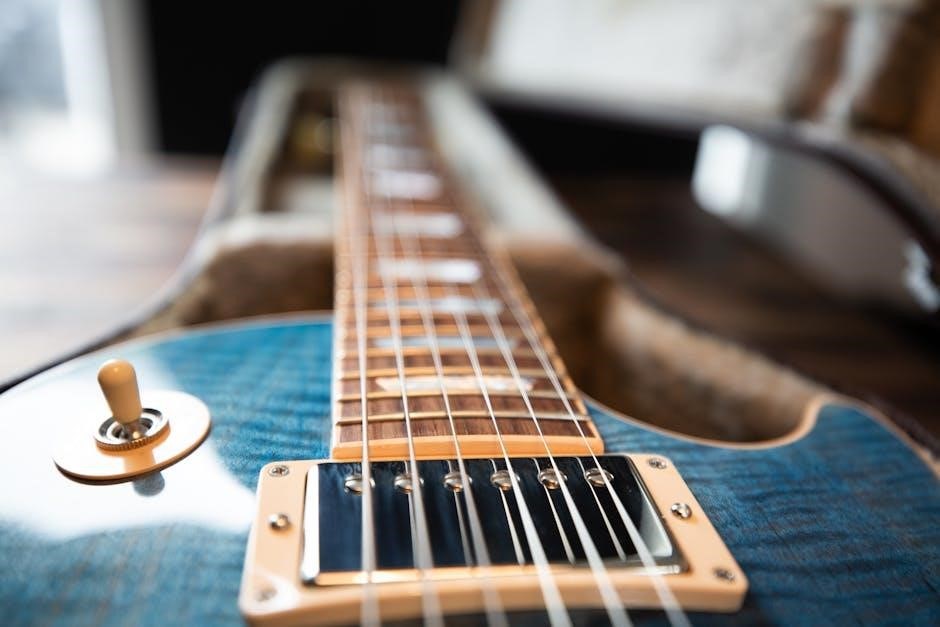Jazz guitar chords are foundational for creating rich, harmonic sounds in jazz music. They combine complexity with versatility, offering expressive voicings that enhance musicality. Essential for any serious jazz guitarist, these chords provide a deeper harmonic language, enabling intricate improvisation and accompaniment. Their unique voicings and extensions add color and tension, making them indispensable for modern jazz playing.
1.1 What Are Jazz Guitar Chords?
Jazz guitar chords are extended chord voicings that incorporate 7ths, 9ths, 11ths, and altered tones, creating rich, complex harmonies. They differ from basic chords by adding extended intervals and altered notes, which are fundamental to jazz harmony. These chords are essential for improvisation and comping, providing a deeper harmonic language. Resources like The Jazz Guitar Chord Book and the Berklee Jazz Guitar Chord Dictionary offer comprehensive guides to these voicings, helping guitarists master the intricacies of jazz harmony and expand their musical expression.
1.2 Importance of Jazz Chords in Guitar Playing
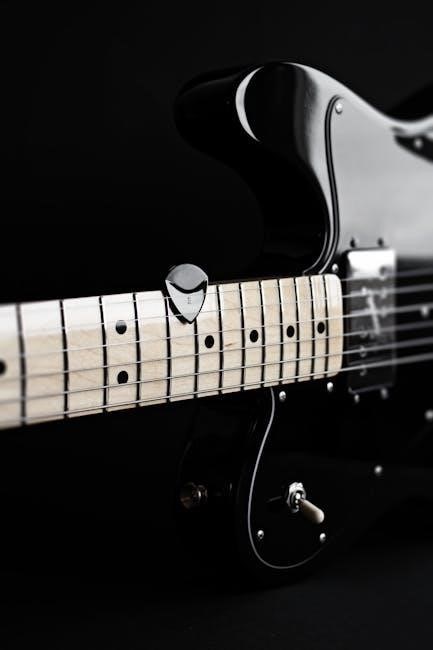
Jazz chords are vital for adding harmonic depth and complexity to guitar playing. They enable players to express intricate emotions and dynamics, essential for jazz improvisation and accompaniment. Mastering these chords enhances versatility, allowing guitarists to adapt to various musical settings. Resources like The Jazz Guitar Chord Book and Berklee’s dictionary provide structured learning paths, ensuring players can grasp and apply these chord voicings effectively, elevating their overall musicianship and ability to contribute to jazz ensembles.

Basic Jazz Guitar Chord Voicings
Basic jazz guitar chord voicings include Drop 2 and Shell chords, providing a solid foundation for harmonic playing. These simplified shapes are easy to learn and versatile, allowing guitarists to build complex sounds while maintaining clarity. They are essential for developing a strong rhythmic and melodic sense in jazz guitar playing, as highlighted in resources like The Jazz Guitar Chord Book and Berklee’s chord dictionaries.
2.1 Drop 2 Chords: Definition and Usage
Drop 2 chords are fundamental in jazz guitar, created by dropping the second highest note of a chord to the bass. This voicing is played on four adjacent strings and is highly versatile for comping, melody, and improvisation. Their open-position structure makes them easy to play and transpose across keys. Widely used in jazz standards, Drop 2 chords are essential for building harmonic depth and rhythmic interest, as demonstrated in The Jazz Guitar Chord Book and Berklee resources.
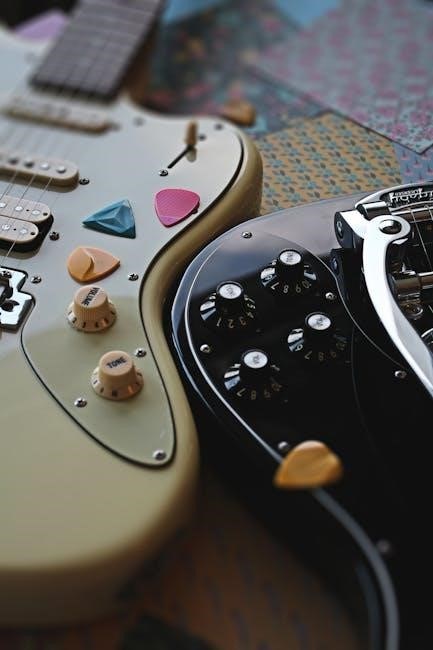
2.2 Shell Chords: Simplified Jazz Chord Shapes
Shell chords are simplified versions of jazz chords, focusing on the core notes: root, third, and seventh. These minimal voicings provide a clear harmonic foundation while allowing for rhythmic flexibility. Often used in jazz standards, shell chords are ideal for rhythm playing and as a base for more complex extensions. Their simplicity makes them accessible to beginners while offering a solid framework for advanced players to build upon, as seen in resources like The Jazz Guitar Chord Book and Berklee materials.

Advanced Jazz Guitar Chord Techniques
Advanced techniques involve complex chord extensions like Major 7th and altered dominants, adding depth and emotional nuance to jazz playing. These voicings enhance harmonic sophistication.
3.1 Major 7th Chords: Construction and Application
Major 7th chords are a cornerstone of jazz harmony, built by adding the 7th note to a major triad. This creates a rich, resonant sound ideal for melodic lines and smooth progressions. Guitarists often use these chords to add color and sophistication to their playing. For example, a C Major 7th chord consists of notes C, E, G, and B. These voicings are versatile, fitting seamlessly into various jazz contexts, from comping to intricate solos, making them essential for any jazz guitarist aiming to expand their harmonic palette and musical expression.
3.2 Altered Dominant Chords: Adding Tension in Jazz
Altered dominant chords are pivotal in jazz for creating harmonic tension and release. By modifying the 5th, 7th, or 9th of a dominant chord, musicians craft dissonant, emotionally rich sounds. For instance, an E7alt chord includes flat and sharp extensions like b9 and #9. These voicings are often used in solos and comping to add complexity and depth. Altered dominants are essential for navigating chord progressions like the II-V-I, making them a cornerstone of jazz guitar technique and a key element in advanced musical expression.
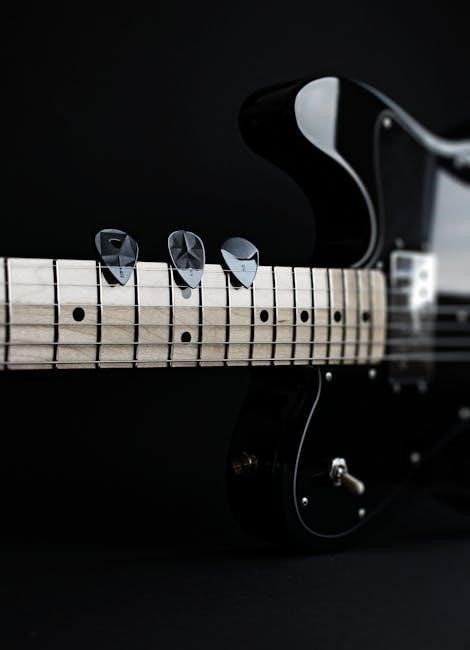
Berklee Jazz Guitar Chord Dictionary
The Berklee Jazz Guitar Chord Dictionary is a comprehensive resource for 7th-chord voicings and essential jazz chord shapes. It provides detailed fretboard diagrams and practical applications, helping guitarists master complex harmonies and expand their musical vocabulary with precision and clarity.
4.1 Overview of the Berklee Chord Dictionary
The Berklee Jazz Guitar Chord Dictionary offers a thorough guide to 7th-chord voicings and common jazz chord shapes. It includes detailed fretboard diagrams, ensuring guitarists can accurately locate and play complex chords. The dictionary covers essential harmonic structures, providing a solid foundation for jazz improvisation and composition. By focusing on practical applications, it helps musicians integrate advanced chords into their playing seamlessly. This resource is invaluable for both intermediate and advanced players seeking to refine their jazz guitar skills and expand their musical expression.
4.2 Essential 7th-Chord Voicings for Jazz Guitar
7th-chord voicings are fundamental to jazz guitar, adding depth and complexity to harmonic structures. These chords, such as major 7th, minor 7th, and dominant 7th, are essential for capturing the rich, nuanced sound of jazz. They are widely used in comping, soloing, and chord melodies, providing a versatile harmonic foundation. Learning these voicings allows guitarists to navigate common progressions like the II-V-I with confidence. The Berklee Chord Dictionary emphasizes these voicings, offering clear diagrams and practical applications for mastering jazz harmony and improvisation effectively.
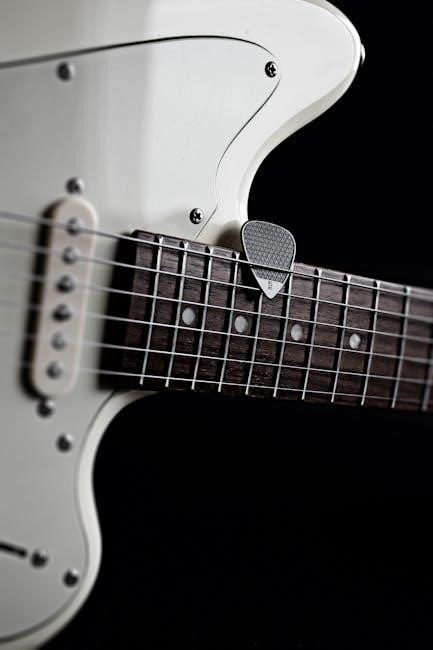
Free Jazz Guitar PDF Resources
Discover free PDF resources like The Jazz Guitar Chord Book by Dirk Laukens, offering chord charts, diagrams, and lessons for mastering jazz guitar harmony and technique effectively.
5.1 The Jazz Guitar Chord Book by Dirk Laukens
The Jazz Guitar Chord Book by Dirk Laukens is a comprehensive guide offering detailed chord constructions and practical playing techniques. It covers essential topics like drop 2 chords, shell chords, and II-V-I progressions. The book includes 28 pages of in-depth lessons, making it a valuable resource for both beginners and advanced players. Available as a free PDF, it provides clear diagrams and tabs, helping guitarists master complex jazz harmonies and apply them effectively in various musical contexts.
5.2 Printable PDF Charts for Jazz Chords and Diagrams
Printable PDF charts for jazz chords and diagrams are invaluable resources for guitarists. These charts provide clear, organized layouts of chord shapes, finger positions, and string groupings. They cover essential voicings like major 7th, minor 7th, and dominant 7th chords, often in multiple keys. Many PDFs include detailed tabs and diagrams for drop 2 chords, shell chords, and altered dominant chords. Free and easily accessible, these charts are perfect for practice, helping guitarists master complex jazz harmonies and apply them in various musical contexts efficiently.
Applying Jazz Chords in Practice
Applying jazz chords involves integrating them into real-world musical contexts. Use chord melodies to blend harmony and melody, and explore lead sheets for practical harmonic applications. Mastering II-V-I progressions is essential for navigating jazz standards, while drop 2 and shell chords enhance both improvisation and accompaniment, providing a solid foundation for expressive jazz playing.
6.1 Chord Melodies: Combining Chords and Single-Note Lines
Chord melodies blend chords and single-note lines to create a harmonically rich, melodic sound. This technique is essential for jazz guitarists, allowing them to outline chord progressions while maintaining a strong melodic presence. By combining chord voicings with single-note phrases, players can craft intricate, engaging solos. Chord melodies are particularly effective in jazz standards, where they can be used to reinterpret familiar tunes. Resources like lead sheets and chord charts provide a foundation for experimenting with this approach, enabling guitarists to develop their own unique melodic style while staying true to the harmonic structure.
6.2 II-V-I Progressions: The Backbone of Jazz Harmony
II-V-I progressions are the cornerstone of jazz harmony, offering a versatile framework for improvisation and composition. This sequence, typically consisting of a ii chord, a V chord, and a I chord, provides a harmonic foundation for countless jazz standards. Guitarists can transpose these progressions to various keys, allowing for endless creative exploration. Resources like lead sheets and chord charts provide practical guidance for mastering these essential harmonic structures, making them indispensable for any jazz guitarist aiming to deepen their understanding of jazz improvisation and harmony.
Turnarounds and Licks in Jazz Guitar
Turnarounds and licks are essential for adding harmonic interest and concluding phrases. They provide a smooth transition to new sections, enhancing rhythm and lead playing with melodic flair.
7.1 10 Essential Jazz Guitar Turnaround Licks
Turnaround licks are short melodic phrases that conclude a section or transition to a new key. They add harmonic interest and rhythmic flair to solos. These licks often use chord tones and chromatic passing notes to create tension and release. Practicing these licks over II-V-I progressions helps integrate them into your playing. They enhance rhythm and lead guitar work, making your solos more engaging. Learning these essential licks provides a solid foundation for improvisation and adds variety to your jazz guitar repertoire.
7.2 Using Drop 2 Chords in Jazz Improvisation
Drop 2 chords are versatile and widely used in jazz improvisation. They involve dropping the second highest note, creating a rich, smooth sound. These chords are excellent for comping, soloing, and chord melodies. Using drop 2 chords adds harmonic depth and rhythmic interest to your playing. They are particularly effective in creating seamless transitions between chord changes. Practicing these voicings over II-V-I progressions can enhance your improvisational skills. Drop 2 chords are a cornerstone of modern jazz guitar, offering a balance of complexity and playability that elevates your musical expression.
Mastering jazz guitar chords opens doors to rich harmonic expression. Resources like The Jazz Guitar Chord Book and Berklee’s dictionary provide essential tools. Explore and practice to refine your skills.
8.1 Final Thoughts on Mastering Jazz Guitar Chords
Mastering jazz guitar chords is a rewarding journey that enhances musical expression. By studying resources like The Jazz Guitar Chord Book and practicing voicings, players gain a deeper harmonic understanding. These tools, including Berklee’s Jazz Guitar Chord Dictionary, provide essential frameworks for improvisation and accompaniment. Regular practice and exploration of these chord shapes will refine your skills, allowing you to navigate complex progressions with confidence. Embrace the process, and let these chords become the foundation of your jazz guitar journey.
8.2 Encouragement to Explore Further Resources
Exploring further resources is key to deepening your understanding of jazz guitar chords. Consider diving into The Jazz Guitar Chord Book by Dirk Laukens or the Berklee Jazz Guitar Chord Dictionary for comprehensive insights. These resources, along with free PDFs and eBooks, offer a wealth of knowledge to refine your skills. Don’t hesitate to explore online tutorials and forums, where you’ll find chord charts, lessons, and tips from experienced players. Embrace the journey of continuous learning and enjoy the creative freedom that mastery of jazz guitar chords brings.
